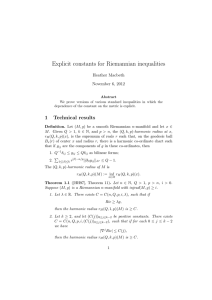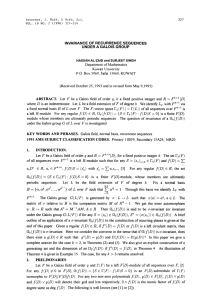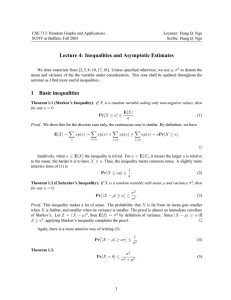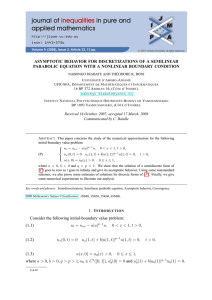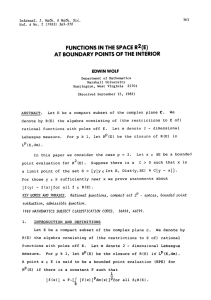Electronic Journal of Differential Equations, Vol. 2013 (2013), No. 108,... ISSN: 1072-6691. URL: or
advertisement
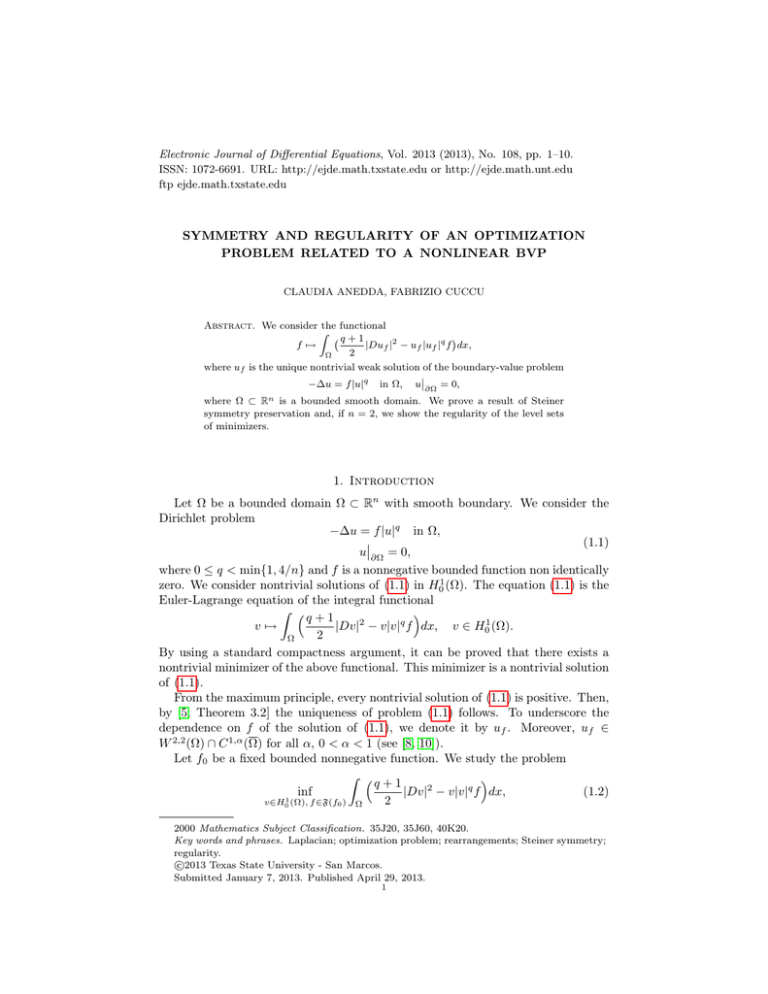
Electronic Journal of Differential Equations, Vol. 2013 (2013), No. 108, pp. 1–10.
ISSN: 1072-6691. URL: http://ejde.math.txstate.edu or http://ejde.math.unt.edu
ftp ejde.math.txstate.edu
SYMMETRY AND REGULARITY OF AN OPTIMIZATION
PROBLEM RELATED TO A NONLINEAR BVP
CLAUDIA ANEDDA, FABRIZIO CUCCU
Abstract. We consider the functional
Z
´
`q + 1
f 7→
|Duf |2 − uf |uf |q f dx,
2
Ω
where uf is the unique nontrivial weak solution of the boundary-value problem
˛
= 0,
−∆u = f |u|q in Ω, u˛
∂Ω
where Ω ⊂ Rn is a bounded smooth domain. We prove a result of Steiner
symmetry preservation and, if n = 2, we show the regularity of the level sets
of minimizers.
1. Introduction
Let Ω be a bounded domain Ω ⊂ Rn with smooth boundary. We consider the
Dirichlet problem
−∆u = f |u|q in Ω,
(1.1)
u = 0,
∂Ω
where 0 ≤ q < min{1, 4/n} and f is a nonnegative bounded function non identically
zero. We consider nontrivial solutions of (1.1) in H01 (Ω). The equation (1.1) is the
Euler-Lagrange equation of the integral functional
Z q+1
v 7→
|Dv|2 − v|v|q f dx, v ∈ H01 (Ω).
2
Ω
By using a standard compactness argument, it can be proved that there exists a
nontrivial minimizer of the above functional. This minimizer is a nontrivial solution
of (1.1).
From the maximum principle, every nontrivial solution of (1.1) is positive. Then,
by [5, Theorem 3.2] the uniqueness of problem (1.1) follows. To underscore the
dependence on f of the solution of (1.1), we denote it by uf . Moreover, uf ∈
W 2,2 (Ω) ∩ C 1,α (Ω) for all α, 0 < α < 1 (see [8, 10]).
Let f0 be a fixed bounded nonnegative function. We study the problem
Z q+1
2
q
inf
|Dv|
−
v|v|
f
dx,
(1.2)
2
v∈H01 (Ω), f ∈F(f0 ) Ω
2000 Mathematics Subject Classification. 35J20, 35J60, 40K20.
Key words and phrases. Laplacian; optimization problem; rearrangements; Steiner symmetry;
regularity.
c
2013
Texas State University - San Marcos.
Submitted January 7, 2013. Published April 29, 2013.
1
2
C. ANEDDA, F. CUCCU
EJDE-2013/108
where, denoting by |A| the Lebesgue measure of a set A,
F(f0 ) = {f ∈ L∞ (Ω) : |{f ≥ c}| = |{f0 ≥ c}| ∀c ∈ R};
(1.3)
here F(f0 ) is called class of rearrangements of f0 (see [9]).
Problems of this kind are not new; see for example [1, 2, 3, 5]. From the results
in [5] it follows that (1.2) has a minimum and a representation formula. Let
Z q+1
E(f ) = inf1
|Dv|2 − v|v|q f dx.
(1.4)
2
v∈H0 (Ω) Ω
Renaming q 0 the constant q and putting p = 2 and q 0 = q + 1 in [5] we have
E(f ) =
where
q0
0
H01 (Ω) 2 − q
I(f ) = sup
q0 − 2
I(f ),
2
Z 0
2
f |v|q − |Dv|2 dx
0
Ω q
is defined in the same paper. By [5, Theorem 2.2] it follows that there exist minimizers of E(f ) and that, if f is a minimizer, there exists an increasing function φ
such that
(1.5)
f = φ(uf ).
We denote by supp f the support of f , and we call a level set of f the set
{x ∈ Ω : f (x) > c}, for some constant c.
In Section 2, we consider a Steiner symmetric domain Ω and f0 bounded and
nonnegative, such that | supp f0 | < |Ω|. Under these assumptions, we prove that
the level sets of the minimizer f are Steiner symmetric with respect to the same
hyperplane of Ω. As a consequence, we have exactly one optimizer when Ω is a
ball.
Chanillo, Kenig and To [4] studied the regularity of the minimizers to the problem
Z
Z
2
λ(α, A) =
inf
|Du| dx + α
u2 dx,
1
u∈H0 (Ω), kuk2 ,|D|=A
Ω
D
2
where Ω ⊂ R is a bounded domain, 0 < A < |Ω| and α > 0. In particular they
prove that, if D is a minimizer, then ∂D is analytic.
In Section 3, following the ideas in [4], we give our main result. We restrict our
attention to Ω ⊂ R2 . Let b1 , . . . , bm > 0 and 0 < a1 < · · · < am < |Ω|, m ≥ 2, be
fixed. Consider f0 = b1 χG1 + · · · + bm χGm , where |Gi | = ai for all i, Gi ⊂ Gi+1 ,
i = 1, . . . , m − 1.
We call η the minimum in (1.2); i.e.,
Z q+1
η=
|Duf |2 − uf |uf |q f dx,
2
Ω
where f and uf are, respectively, the minimizing function and the corresponding
solution of (1.1).
In this case (1.5) becomes
m
X
f=
bi χDi ,
i=1
where
D1 = {uf > c1 },
D2 = {uf > c2 },
...,
Dm = {uf > cm },
EJDE-2013/108
SYMMETRY AND REGULARITY
3
for suitable constants c1 > c2 > · · · > cm > 0.
We show regularity of ∂Di for each i proving that |Duf | > 0 in ∂Di . Following
the method used in [4], we consider
Z q+1
(1.6)
|Duf + sDv|2 − (uf + sv)|uf + sv|q f t dx − η,
E(s, t) =
2
Ω
where v ∈ H01 (Ω), f t is a family of functions such that f t ∈ F(f0 ) with f 0 = f , and
s ∈ R. We have
E(s, t) ≥ E(0, 0) = 0 ∀s, t.
Therefore, (s, t) = (0, 0) is a minimum point; it follows that
2
∂ E2 (0, 0) ∂ 2 E (0, 0)
∂s
∂s∂t
≥ 0.
2
∂ E (0, 0) ∂ 2 E
(0,
0)
∂t∂s
∂t2
(1.7)
Expanding (1.7) in detail and using some lemmas from [4] we prove that the boundaries of level sets of f are regular.
Pm
Pm
Theorem 1.1. Let Ω ⊂ R2 , f0 = i=1 bi χGi with m ≥ 2, and f = i=1 bi χDi a
minimizer of (1.2). Then |Duf | > 0 on ∂Di , i = 1, . . . , m.
2. Symmetry
In this section we consider Steiner symmetric domains. We prove that, under
suitable conditions on f0 in (1.3), minimizers inherit Steiner symmetry.
Definition 2.1. Let P ⊂ Rn be a hyperplane. We say that a set A ⊂ Rn is Steiner
symmetric relative to the hyperplane P if for every straight line L perpendicular
to P , the set A ∩ P is either empty or a symmetric segment with respect to P .
To prove the symmetry, we need [6, Theorem 3.6 and Corollary 3.9], that, for
more convenience for the reader, we state here. These results are related to the
classical paper [7].
Theorem 2.2. Let Ω ⊂ Rn be bounded, connected and Steiner symmetric relative
to the hyperplane P . Assume that u : Ω → R has the following properties:
• u ∈ C(Ω) ∩ C 1 (Ω), u > 0 in Ω, u|∂Ω = 0;
• for all φ ∈ C0∞ (Ω),
Z
Z
Du · Dφ dx =
φF (u) dx,
Ω
Ω
where F has a decomposition F = F1 + F2 such that F1 : [0, ∞) → R is
locally Lipschitz continuous, while F2 : [0, ∞) → R is non-decreasing and
identically 0 on [0, ] for some > 0.
∂u
Then u is symmetric with respect to P and ∂v
(x) < 0, where v is a unit vector
orthogonal to P and x belongs to the part of Ω that lies in the halfspace (with origin
in P ) in which v points.
Theorem 2.3. Let Ω be Steiner symmetric and f0 a bounded nonnegative function.
If | supp f0 | < |Ω| and f ∈ F(f0 ) is a minimizer of (1.2), then the level sets of f
are Steiner symmetric with respect to the same hyperplane of Ω.
4
C. ANEDDA, F. CUCCU
EJDE-2013/108
Proof. Let u = uf be the solution of (1.2). Then u ∈ C 0 (Ω) ∩ C 1 (Ω) and satisfies
Z
Z
Du · Dψ dx =
ψf uq dx ∀ψ ∈ C0∞ (Ω).
Ω
Ω
Since u > 0 and since (from (1.5)) f = φ(u) with φ increasing function, it follows
that φ(u) ≡ 0 on {x ∈ Ω : u(x) < d} for some positive constant d. Then we have
uq f = F1 (u) + F2 (u) with F1 (u) ≡ 0 and F2 (u) = φ(u)uq . From Theorem 2.1 and
f = φ(u) we have the assertion.
Remark 2.4. By this theorem, if Ω is an open ball and | supp f0 | < |Ω|, then f is
radially symmetric and decreasing.
3. Regularity of the free boundaries
In this section we prove the following result.
Pm
Pm
Theorem 3.1. Let Ω ⊂ R2 , f0 = i=1 bi χGi with m ≥ 2, and f = i=1 bi χDi a
minimizer of (1.2). Then |Duf | > 0 on ∂Di , i = 1, . . . , m.
We use the notation introduced in Section 1. Without loss of generality we can
assume m = 3; the general case easily follows. Let f = b1 χD1 + b2 χD2 + b3 χD3 . We
will prove |Duf | > 0 in ∂D2 ; we omit the proof for D1 and D3 because it is similar.
We define the family f t by replacing only the set D2 by a family of domains D2 (t).
First of all, we explain how to define the family D2 (t).
In the sequel we use the notation introduced in [4], reorganized according to our
needs.
We call a curve γ : [a, b] → R, −∞ < a < b < ∞, regular if:
(i) it is simple, that is: if a ≤ x < y ≤ b and x 6= a or y 6= b, then γ(x) 6= γ(y);
(ii) kγkC 2 (a,b) is finite;
(iii) |γ 0 | is uniformly bounded away from zero.
If, in addiction, γ(a) = γ(b), we say that the curve is closed and regular. If the
domain of γ is (a, b) we say that γ is regular (respectively, closed and regular) if
the continuous extension of γ to [a, b] is regular (respectively, closed and regular).
Now, we introduce the notation
F := ∂D2 ;
F ∗ := F ∩ {|Duf | > 0}.
Let J = ∪pk=1 Jk be a finite union of open bounded intervals Jk ⊂ R, γ = (γ1 , γ2 ) :
J → F ∗ a simple curve which is regular on each interval Jk and γ(J) ⊂ F ∗ .
We suppose that dist γ(Jk ), γ(Jh ) > 0 for 1 ≤ h 6= k ≤ p. Assume
also that
|γ 0 | ≥ θ on J. For each ξ ∈ J, we denote by N(ξ) = N1 (ξ), N2 (ξ) the outward
unit normal with respect to D2 at γ(ξ). We also define the tangent vector to γ
N⊥ (ξ) = − N2 (ξ), N1 (ξ) , and N0 the first derivative of N.
Reversing the direction of γ if necessary, we will assume, without loss of generality, that γ 0 and N⊥ have the same direction; i.e., ∠γ 0 , N⊥ i = |γ 0 |. We observe
that, because γ is C 2 and simple on Jk , for each k there exists βk > 0 such that
the function
φk : Jk × [−βk , βk ] → R2 , (ξ, β) 7→ (x1 , x2 ) = φk (ξ, β) = γ(ξ) + βN(ξ)
is injective.
EJDE-2013/108
SYMMETRY AND REGULARITY
5
Because dist γ(Jk ), γ(Jh ) > 0 for all h 6= k, we can find a number β0 > 0
and we can paste together the functions φk to obtain a function
φ injective on
J × [−β0 , β0 ]. Choose
β
such
that
dist
φ(J
×
[−β
,
β
]),
∂D
>
0
and
dist φ(J ×
0
0
0
1
[−β0 , β0 ]), ∂D3 > 0.
Now, we define
K = D2 \ φ J × (−β0 , 0] ;
for t ∈ (−t0 , t0 ) we define
D2 (t) = K ∪ {φ(ξ, β) : ξ ∈ J, β < g(ξ, t)},
(3.1)
where g : J × (−t0 , t0 ) → R, t0 > 0, is a function such that
g(ξ, t), gt (ξ, t), gtt (ξ, t) ∈ C(J) ∀t ∈ (−t0 , t0 )
(3.2)
and
g(ξ, 0) ≡ 0
∀ξ ∈ J.
(3.3)
We observe that D2 (0) = D2 . Next we compute the measure of D2 (t). Put A(t) =
|D2 (t)| and A = |D2 (0)| = |D2 |; we have
Z Z g(ξ,t)
A(t) = |D2 | +
J(ξ, β)dβdξ,
J
0
where
0
0
∂(x1 , x2 ) γ1 + βN1 N1 J(ξ, β) =
=
∂(ξ, β)
γ20 + βN20 N2 = − hγ 0 , N⊥ i − βhN0 , N⊥ i = |γ 0 | + βhN0 , N⊥ i.
We show that |γ 0 | + βhN0 , N⊥ i ≥ 0. Indeed, from the fact that kγkC 2 (J) < ∞,
we have khN0 , N⊥ ikL∞ (J) < ∞. Substituting t0 by a smaller positive number if
necessary, we can assume that
kgkL∞ (J×(−t0 ,t0 )) < β0
and
khN0 , N⊥ ikL∞ (J) kgkL∞ (J×(−t0 ,t0 )) < θ.
Note that the first of these assumptions guarantees that ∂D2 (t) has positive distance
from ∂D1 and ∂D3 . We have
|β| hN0 , N⊥ i ≤ kgkL∞ (J×(−t0 ,t0 )) khN0 , N⊥ ikL∞ (J) ≤ θ ≤ |γ 0 |
for all ξ ∈ J and |β| ≤ kgkL∞ (J×(−t0 ,t0 )) . Thus, J(ξ, β) = |γ 0 | + βhN0 , N⊥ i.
Substituting into the formula for A(t) we have
Z Z g(ξ,t)
A(t) = A +
(|γ 0 | + βhN0 , N⊥ i)dβdξ
ZJ 0
1
=A+
g(ξ, t)|γ 0 | + (g(ξ, t))2 hN0 , N⊥ i dξ.
2
J
To obtain |D2 (t)| = |D2 | for all t ∈ (−t0 , t0 ), we find the further constraint on g:
Z 2
1
g(ξ, t)|γ 0 | +
g(ξ, t) hN, N⊥ i dξ = 0 ∀t ∈ (−t0 , t0 ).
(3.4)
2
J
6
C. ANEDDA, F. CUCCU
EJDE-2013/108
Moreover, we calculate the derivatives of A(t), that we will use later.
Z
A0 (t) =
gt (ξ, t)|γ 0 (ξ)| + g(ξ, t)gt (ξ, t)hN0 , N⊥ i dξ = 0;
J
Z
00
A (t) =
gtt (ξ, t)|γ 0 (ξ)| + g(ξ, t)gtt (ξ, t) + gt2 (ξ, t) hN0 , N⊥ i dξ = 0.
(3.5)
J
Once we have defined the family D2 (t), we can go back to the functional (1.6).
The following lemma describes (1.7) with f t = b1 χD1 + b2 χD2 (t) + b3 χD3 . We find
an inequality corresponding to [4, (2.3) of Lemma 2.1].
Lemma 3.2. Let f t = b1 χD1 + b2 χD2 (t) + b3 χD3 , where the variation of domain
D2 (t) is described by (3.1) and g : J × (−t0 , t0 ) → R, t0 > 0, satisfies (3.2), (3.3)
and (3.4). Then, for all v ∈ H01 (Ω), the conditions (1.7) becomes
Z
Z
|Dv|2 − quf v 2 |uf |q−2 f dx · gt2 (γ −1 , 0)|Duf |dσ
γ
Ω
(3.6)
2
Z
q
−1
≥ b2 c2
gt (γ , 0) vdσ .
γ
Proof. We calculate the second derivative of the functional (1.6), with respect to s.
We have
Z
∂E
= (q + 1)
hDuf + sDv, Dvi − v|uf + sv|q f t dx
∂s
Ω
and
Z
∂2E
(0,
0)
=
(q
+
1)
|Dv|2 − quf v 2 |uf |q−2 f dx.
(3.7)
2
∂s
Ω
Before calculating the second derivative of E with respect to t, we rewrite (1.6) in
the form
Z
Z
q+1
2
|Duf + sDv| dx − b1
E(s, t) =
(uf + sv)|uf + sv|q dx
2
Ω
D1
Z
Z
q
− b2
(uf + sv)|uf + sv| dx − b3
(uf + sv)|uf + sv|q dx − η.
D2 (t)
D3
2
We observe that, if F : R → R is a continuous function, then
Z
Z
Z Z g(ξ,t)
F−
F =
F φ(ξ, g(ξ, β)) J(ξ, β)dβdξ;
D2 (t)
D2
J
0
whence, from the Fundamental Theorem of Calculus,
Z
Z
∂
F =
gt (ξ, t)F φ(ξ, g(ξ, t)) J(ξ, g(ξ, t))dξ.
∂t D2 (t)
J
q
Using the above relation with F = (u + sv)u + sv , we have
Z
q
∂E
= −b2 gt (ξ, t) uf + sv uf + sv J(ξ, g(ξ, t)) dξ,
∂t
J
where, for simplicity of notation, we set uf φ(ξ, g(ξ, t)) = uf and v φ(ξ, g(ξ, t)) =
v. Moreover
Z
n
∂2E
q
=
−b
|u
+
sv|
gtt (ξ, t)(uf + sv) + (q + 1)gt2 (ξ, t)hDuf + sDv, Ni
2
f
2
∂t
J
o
× J(ξ, g(ξ, t)) + gt2 (ξ, t)(uf + sv)hN0 , N⊥ i dξ,
EJDE-2013/108
SYMMETRY AND REGULARITY
7
where we have used that
∂
uf φ(ξ, g(ξ, t)) = hDuf φ(ξ, g(ξ, t)) , Nigt (ξ, t),
∂t
∂
J(ξ, g(ξ, t)) = gt hN0 , N⊥ i.
∂t
We note that, when t = 0,
uf φ(ξ, g(ξ, t)) = uf (γ(ξ)) = c2 ,
Duf φ(ξ, g(ξ, 0)) = −|Duf γ(ξ) |N(ξ) and J(ξ, g(ξ, 0)) = J(ξ, 0) = |γ 0 (ξ)|. Evaluating the above expression in (0, 0), we find
Z h
i
∂2E
q+1
0
2
0
⊥
(0,
0)
=
−b
c
g
(ξ,
0)|γ
(ξ)|
+
g
(ξ,
0)hN
,
N
i
dξ
2
tt
t
2
∂t2
J
Z
+ b2 cq2 (q + 1) gt2 (ξ, 0)|Duf (γ(ξ))||γ 0 (ξ)|dξ.
J
By using (3.5) with t = 0 we find
∂2E
(0, 0) = b2 cq2 (q + 1)
∂t2
Z
= b2 cq2 (q + 1)
Z
J
γ
gt2 (ξ, 0)|Duf (γ(ξ))| |γ 0 (ξ)|dξ
(3.8)
gt2 (γ −1 , 0)|Duf | dσ.
We also have
∂2E
= −b2 (q + 1)
∂s∂t
Z
J
gt (ξ, t)v|uf + sv|q J(ξ, g(ξ, t)) dξ;
that is,
∂2E
(0, 0) = −b2 cq2 (q + 1)
∂s∂t
=
−b2 cq2 (q
Z
ZJ
+ 1)
gt (ξ, 0) v γ(ξ) |γ 0 (ξ)| dξ
(3.9)
gt (γ −1 , 0) v dσ.
γ
Using (1.7) in the form
∂2E
2
∂2E
∂2E
(0,
0)
(0,
0)
≥
(0,
0)
,
∂s2
∂t2
∂s∂t
and using (3.7), (3.8) and (3.9) in this inequality, we obtain (3.6).
Note that in inequality (3.6) only g(γ −1 , 0) appears. Moreover, g(γ −1 , 0) has
null integral on γ. Indeed, differentiating (3.4) with respect to t and putting t = 0,
we obtain
Z
g(ξ, 0)|γ 0 |dξ = 0.
J
Now a natural question arises: does inequality (3.6) hold for any function h with
null integral on γ? The answer is contained in the following result.
Lemma 3.3. Let J and Rγ be the same as described. Let h : γ → R bounded,
continuous and such that γ h dσ = 0. Then, for all v ∈ H01 (Ω) and for all a ∈ R
we have
Z Z
Z
2
|Dv|2 − quf v 2 |uf |q−2 f dx · h2 |Duf | dσ ≥ b2 cq2
h(v − a) dσ . (3.10)
Ω
γ
γ
8
C. ANEDDA, F. CUCCU
EJDE-2013/108
The proof of the above lemma is similar to that of [4, Lemma 2.2]; we omit it.
The following lemma is an analogue to [4, Lemma 3.1].
Lemma 3.4. Let P be a point on F = ∂{uf > c2 }. Suppose that for all k ∈ Z+
there exist a positive number rk , a bounded open interval Jk and a regular curve
γk : Jk → F ∗ such that r1 > r2 > · · · → 0, γk (Jk ) ⊂ F ∗ ∩ Brk (P ) \ Brk+1 (P ). Then
we must have
∞ Z
X
1
dσ < ∞.
|Du
γ(Jk )
f|
k=1
Proof. Without loss of generality, we assume that P is the origin. We suppose also
that Jk ∩ Jh = ∅ for all k 6= h, and denote all γk with γ. We define
(
Jk ∪ Jk+1 ∪ · · · ∪ Jm if m ≥ k,
Jk,m =
∅
otherwise.
We suppose by contradiction that
∞ Z
X
k=1
γ(Jk )
1
dσ = ∞.
|Duf |
Let V be a smooth radial function in R2 ,
V (x) = 2,
1 < V (x) < 2,
0 < V (x) < 1,
V (x) = 0,
(3.11)
decreasing in |x|, defined by
|x| = 0
0 < |x| < 1/2
1/2 < |x| < 1
|x| ≥ 1.
For all k ∈ Z+ we define vk (x) = V ( rxk ).
supp vk ⊂ Ω. Now we fix k; we have
vk (x) − 1 = 1,
0 < v (x) − 1 < 1,
k
−1
<
vk (x) − 1 < 0,
vk (x) − 1 = −1,
Consider k large enough such that
|x| = 0
0 < |x| < rk /2
rk /2 < |x| < rk
|x| ≥ rk .
Since Jk and |γ 0 | are bounded, γ(Jk ) is of finite length. Moreover, |Duf | is uniformly
bounded away from 0 on γ(Jk ) since γ(Jk ) ⊂ F ∗ . Together with the fact that
γ(J1,k−1 ) ⊂ (Brk )C , we have
Z
Z
vk − 1
1
−∞ <
dσ = −
dσ < 0.
γ(J1,k−1 ) |Duf |
γ(J1,k−1 ) |Duf |
Choose m such that rm < rk /2. From the facts that vk (x) − 1 > 0 in Brm ,
γ(Jl ) ⊂ Brm for all l ≥ m and vk (x) − 1 → 1 as x → 0 and (3.11), we have
Z
vk − 1
dσ → ∞ for l → ∞.
γ(Jm,l ) |Duf |
Consequently, there must be a number l ≥ m such that
Z
Z
Z
vk − 1
vk − 1
vk − 1
dσ ≤ −
dσ <
dσ.
γ(Jm,l−1 ) |Duf |
γ(J1,k−1 ) |Duf |
γ(Jm,l ) |Duf |
EJDE-2013/108
SYMMETRY AND REGULARITY
9
Choose a subinterval Jl0 ⊂ Jl such that
Z
Z
Z
vk − 1
vk − 1
vk − 1
dσ +
dσ = −
dσ.
0
|Du
|
|Du
|
γ(Jm,l−1 )
γ(Jl )
γ(J1,k−1 ) |Duf |
f
f
Then we have
Z
γ(J k )
vk − 1
dσ = 0,
|Duf |
where J k = J1,k−1 ∪ Jm,l−1 ∪ Jl0 .
vk −1
and, after
Now we can apply Lemma 3.3 to J k , γ, vk , a = 1 and h = |Du
f|
rearranging, obtain
Z Z
(vk − 1)2
q
2
2
q−2
|Dvk | − quf vk |uf | f dx ≥ b2 c2
dσ.
Ω
γ(J k ) |Duf |
We find that
Z Ω
Z
|Dvk |2 − quf vk2 |uf |q−2 f dx ≤
|DV |2 dx.
B1 (0)
By the above estimate, for a suitable constant C, we have
Z
Z
(vk − 1)2
2
dσ
C
|DV | dx ≥
B1 (0)
γ(J k ) |Duf |
Z
(vk − 1)2
≥
dσ
γ(J1,k−1 ) |Duf |
k−1
XZ
(vk − 1)2
dσ.
=
γ(Jh ) |Duf |
h=1
Then, when k → ∞, we have
Z
∞ Z
X
C
|DV |2 dx ≥
B1 (0)
h=1
γ(Jh )
(vk − 1)2
dσ = +∞,
|Duf |
which is a contradiction. So we must have
∞ Z
X
dσ
< ∞,
γ(Jk ) |Duf |
k=1
as desired.
Lemma 3.5. Let P be a point on F = ∂{uf > c2 }. Suppose that there are
numbers K ∈ Z and σ > 0 such that, for each k ≥ K, there exists a regular curve
γk : Jk → F ∗ with the following two properties:
γ(Jk ) ⊂ F ∗ ∩ B2−k (P ) \ B2−(k+1) (P ),
Z
H1 (γk (Jk )) =
|γ 0 (ξ)|dξ > σ 2−k .
Jk
Then |Duf (P )| > 0.
For a proof of the above lemma, see [4, Lemma 3.2]. From an intuitive point
of view, this lemma says that, if the set ∂{uf > c2 } ∩ {|Duf | > 0} is big enough
around a point of ∂{uf > c2 }, then |Duf | > 0 at this point.
Now, we are able to prove our main theorem.
10
C. ANEDDA, F. CUCCU
EJDE-2013/108
Proof of Theorem 3.1. By using the previous Lemmas and superharmonicity of uf
the Theorem follows from the results of sections 5 and 6 in [4].
Open problems. The method used in this paper to prove regularity does not
work when the number of level sets of f is infinite. Therefore it remains to study
the boundaries of level sets of f in the case of the rearrangement class F(f0 ) of a
general function f0 .
We can obtain an analogous result to Lemma 3.4 for the p-Laplacian operator,
but we cannot go further because we lack a suitable regularity theory for the pLaplacian operator and its solutions. We think that it is reasonable to guess that
a regularity result of the type that we have proven in this work will hold for the
situation with the p-Laplacian when p < 2.
Acknowledgments. The authors want to thank the anonymous referees for their
valuable comments and suggestions.
References
[1] A. Alvino, G. Trombetti and P. L. Lions; On optimization problems with prescribed rearrangements, Nonlinear Analysis, TMA 13 (1989), 185–220.
[2] S. Chanillo, D. Grieser, M. Imai, K. Kurata and I. Ohnishi; Symmetry breaking and other
phenomena in the optimization of eigenvalues for composite membranes, Commun. Math.
Phys.214 (2000), 315–337.
[3] S. Chanillo, D. Grieser and K. Kurata; The free boundary problem in the optimization of
composite membranes, Contemporary Math. 268 (1999), 61–81.
[4] S. Chanillo, C.E. Kenig and G. T. To; Regularity of the minimizers in the composite membrane problem in R2 , Journal of Functional Analysis 255 (2008), 2299–2320.
[5] F. Cuccu, G. Porru and S. Sakaguchi; Optimization problems on general classes of rearrangements, Nonlinear Analysis 74 (2011), 5554–5565.
[6] L.E. Fraenkel; An Introduction to maximum principles and symmetry in elliptic problems,
Cambridge Tracts in Mathematics, Cambridge Univ. Press. (2000).
[7] B. Gidas, W. M. Ni and L. Nirenberg; Symmetry and related properties via the maximum
principle, Comm. Math. Phys. 68, N. 3 (1979), 209–243.
[8] D. Gilbarg, N. S. Trudinger; Elliptic partial differential equations of second order, Springer
Verlag, Berlin, (1977).
[9] B. Kawohl; Rearrangements and convexity of level sets in PDE’s, Lectures Notes in Mathematics, Springer 1150 (1985).
[10] P. Tolksdorff; Regularity for a more general class of quasilinear elliptic equations, Journal of
Differential Equations 51 (1984), 126–150.
Claudia Anedda
Dipartimento di Matematica e Informatica, Universitá di Cagliari, Via Ospedale 72,
09124 Cagliari, Italy
E-mail address: canedda@unica.it
Fabrizio Cuccu
Dipartimento di Matematica e Informatica, Universitá di Cagliari, Via Ospedale 72,
09124 Cagliari, Italy
E-mail address: fcuccu@unica.it



